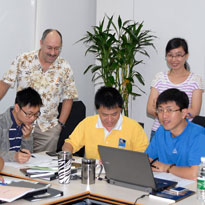ATM Advanced
- Course:ATM Advanced
- Course ID:ATM-ADV Duration:2 days Where: Your Office (7+ Persons)
- Download Course Description (PDF)
Available as a private, customized course for your group at your offices or ours and in some cases as a WebLive(TM) class.
Course Outline
- Overview of ATM Forum (ATMF) Efforts
- Quick review of new spec efforts
- Anchorage, new approved specs, spec watch
- Advanced ATM Physical (PHY) Layer Specs
- Where do the new specs fit in the PHY layer?
- New low-cost connectors for ATM campus nets
- New PHY protocols: 622, 1000, 2498.32 Gbps
- Inverse Multiplexing for ATM: Business case
- Performance objectives and availability
- IMA architecture: Version 1.x, MIB
- Serial UTOPIA, MultiPHY
- ATM Forum’s User-Network Interface
- Its scope, purpose, bearer service attributes and QoS
- Setting up an SVC: Parameters, protocols, elements
- Q.2931, UPC, CAC, NPC, QoS, CLP
- UNI vers. 3.1/4.0/4.1, Spec’d and Unspec’d QoSs
- Specs for SONET and 44.736 Mbps at public UNI
- Specs for 100, 155.52 and 51 Mbps at private UNI
- ATMF Routing and Addressing (RA) Developments
- ATM addressing standards: AESA, DCC, E.164 N/e/A, ICD, local
- Four examples of addressing in connections
- Transported Number Stack (TNS)
- Address types for different network types
- Internetworking addressing examples
- AINI: ATM Internetworking Interface
- Peers, non-peers and Transit networks
- ASP-ASP, Private-Private, bi-level addressing, all BISUP, mixed
- Q.2931 and BISUP
- LAN Emulation (LANE) Developments
- Quick review of LANE version 1 technology
- LANE v2 summary: New services, features, support
- LUNI (LANE User Network Interface) version 2
- LLC Multiplexing, TLVs, Multicasting, QoS
- LNNI (LANE Network Network Interface) & MIB
- Architecture, protocol layers, topology, protocols
- Functions and Services: AALs, Connection Management, Layer
- Management, SCSP services
- Protocols and procedures: LECs to LECs, LES initialization and configuration, connection
- BUS forwarding: Multicast and unicast traffic
- PNNI (Private Network Network I/F) Developments
- PNNI review: Addressing, DTLs, ‘crankback’
- PNNI databases, PTSPs and PTSEs
- PAR: PNNI Augmented Routing
- PPAR: Proxy PAR
- PNNI enhancements & new PNNI MIBs
- Multi-Protocol Over ATM (MPOA) Developments
- Purpose, evolution, requirements
- MPOA alternatives: Tag Switching, MPLS
- MPOA architecture: MPS, NHRP, MPC, ROLC
- Operation: MPC-MPS, MPS-MPS, MPC-MPC control
- MPOA data flows : MPC-MPC, MPC-NHC
- Configuration, discovery, MPOA-NHRP resolution
- Shortcut traffic Data Frame Encapsulations
- MPOA Data Plane Purge mechanism
- Ambiguities: Info at ingress and egress MPCs
- Do new switch routers make MPOA irrelevant?
- ATMF’s Residential Broadband (RBB)
- RBB Architectural Framework: Five parts
- Services, interfaces (HUNI, UNIx, ANI), HAN
- ATM Access Circuits: HFC & PON; connectors
- Alternative access circuits: ADSL, VDSL
- RBB Architectural Framework: Five parts
- Network Management (NM) Spec Update
- Summary review of management models (for SNMP, OSI CMIP/TMN), trade-offs, ILMI MIBs
- ATM M1 – M5 management responsibilities
- M4: Architecture and SNMP/CMIP MIBs
- Network View (NV) interface
- Network Element Management interface: Reqs
- New MIBs: CES, IMA, LANE, MPOA, PNNI, AALs
- Native ATM Connectionless Service (CLS)
- Applications for short lived data exchanges
- Comparison of CLS to MPOA, MPLS, I.364
- Wrap-up: Course Recap, Q/A, and Evaluations
Course in a Nutshell
Asynchronous Transfer Mode (ATM), a key component of Broadband ISDN (B-ISDN), is a widely deployed technology that is recognized for its multimedia capabilities and flexibility. However, it’s not an easy technology to master. This in-depth two-day course is the second of our two courses on ATM. This course picks up where its predecessor leaves off, helping you greatly advance and expand your knowledge of ATM.
Customize It!
Let us know your background and motivations for taking this course so we can adapt it to your requirements. If you need to learn SNMP, SONET/SDH, or other technologies in conjunction with ATM, we can also design combination courses for you. This course can also be taught together with its prequel as an in-depth bootcamp on ATM. We perform most such customization at little to no added cost to you.
Learn How To
- Use the latest ATM terminology
- Keep up with the current spec efforts of the ATM Forum’s Working Groups (WG)
- PHY: Inverse Multiplexing for ATM, UTOPIA, multiPHY I/F, 2.4 Gbps
- Circuit Emulation Services: AAL1 & 2 trunking, NB trunking, DB-CES, AAL-CU
- Voice Telephony over ATM: NB trunking using AAL2 SSCS, VTOA to the Desktop
- Routing, addressing, internetworking (ASP, private, B-ISUP, Q.2931, AINI)
- LAN Emulation: LUNI enhancements, LNNI, new LANE MIBs, issues
- P-NNI : public/private internetworking, MIBs, Leaf-Initiated Joins (LIJs)
- Multi-Protocol Over ATM (MPOA): Architecture, operation, protocols, issues – versus layer 3 switching, Cisco’s Tag Switching and IETF’s MPLS
- Application Program Interface: UNI 4.0, SAP, semantics, Java.net, Winsock
- Residential Broadband: Architecture, services, HUNI, UNIx, ANI, VB5.x
- Network Management: M4 Interface Reqs, Logical MIBs, Network Element View
- Connectionless ATM, pre-reserved QoS bandwidth technology
- Knowledge to give you an early advantage over the competition
- Identify and pursue key issues and ask more penetrating questions
- Integrate your LAN, WAN networks with voice, video and FAX networks
Aimed At
- Users, providers and designers of voice, video and data communications technology
- Telecommunications and data communications service providers
- LAN/WAN networking professionals, architects, integrators and administrators
- Communications engineers, product planners and designers
- Communications marketing and sales support personnel
- IT managers and consultants
- Anyone who deals with voice, video or data networking
- Anyone who needs to stay abreast of strategic communications technologies

